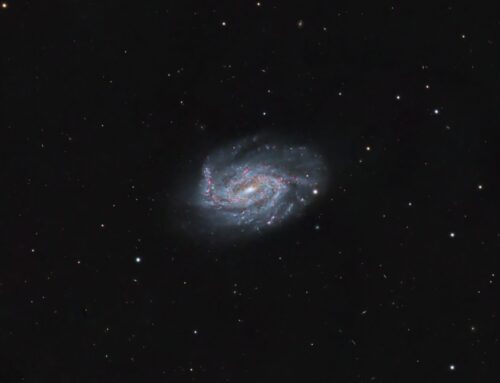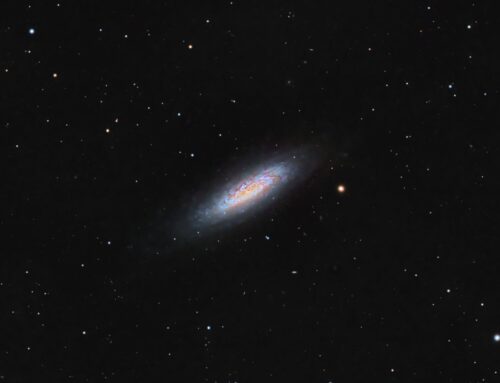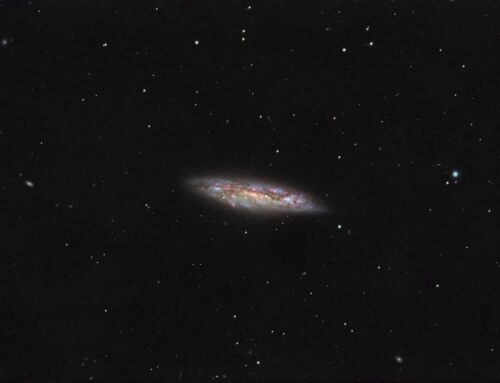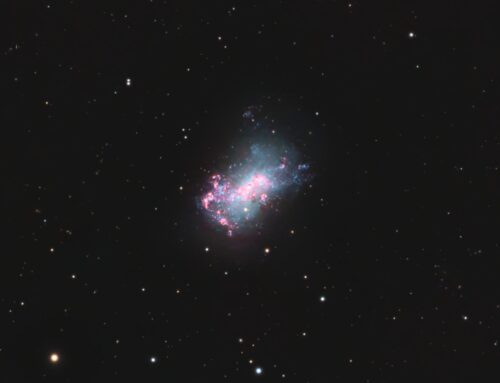M33, Triangulum Galaxy
 Click image for full size version
Click image for full size version
October 11, 2021
M33, familiarly known as the Triangulum Galaxy, is one of the closest large galaxies to Earth. It’s located in the constellation Triangulum at a distance of about 2.5 million light years and has a diameter of around 60,000 light years. It lies not far in the sky from another big, beautiful galaxy: M31. M33 is visible to the naked eye in a dark sky, and is a fine sight in a large telescope. I image it with every setup that I try.
Because of its size and relative closeness to us, M33 displays a wealth of detail in photographs, including a variety of colours in different structures: blue star clusters, pink emission nebulae (similar to our Milky Way’s Orion Nebula), brown dust lanes and a yellowish core. Numerous other galaxies are also in the image, but can easily go unnoticed due to the overwhelming richness of M33.
Tekkies:
Acquisition, focusing, and control of Paramount MX mount with N.I.N.A., TheSkyX and PHD2. Focus with Optec DirectSync motor and controller. Equipment control with PrimaLuce Labs Eagle 4 Pro computer. All pre-processing and processing in PixInsight. Acquired from my SkyShed in Guelph. Above-average transparency and seeing. Data acquired August 2 – September 3, 2021 in a nearly moonless sky.
Luminance: Sky-Watcher Esprit 150 f/7 refractor and QHY600M camera with Optolong UV/IR filter
Chrominance: Takahashi FSQ-106 ED IV @ f/5 and QHY367C Pro one-shot colour camera with Optolong UV/IR filter
51 x 5m OSC = 4hr25m
Total: 8hr45m
Data Reduction and Initial Processing
Preprocessing: The WeightedBatchPreProcessing script was used to create a Luminance master frame from the mono camera and an RGB master frame from the one-shot colour camera. DrizzleIntegration (1x CFA Drizzle) was applied to the RGB set. The RGB master was registered to the Luminance master using StarAlignment.
Gradient Removal: DBE was applied to both masters using Subtraction.
Colour
Colour Balancing: Colour was balanced with PhotometricColorCalibration.
Linear Noise Reduction: MultiscaleLinearTransform was used to reduce noise in the background areas, using an internal mask to protect bright structures. Layer settings for threshold and strength: Layer 1: 5.0 0.95, 2 iterations; Layer 2: 4.0, 0.85, 2 iterations, Layer 3: 3.5 0.75, 1 iteration; Layer 4: 2.0, 0.5, 1 iteration.
Stretching: HistogramTransformation was applied to make a pleasing, bright image, with background set to an intensity of approximately 0.10.
Lightness
Deconvolution: A star mask was made from the Luminance master to use as a Local Deringing Support Image. A stretched copy of the Luminance master was used as a deconvolution mask. . Deconvolution was applied (30 iterations, regularized Richardson-Lucy, ParametricPSF mode with default settings; Global dark deringing = 0.03; Global bright deringing 0.005).
Linear Noise Reduction: MultiscaleLinearTransform was used to reduce noise in the background areas, using an internal mask to protect bright stars and the brighter regions of the galaxy. Layer settings for threshold and strength: Layer 1: 5.0 0.85, 1 iteration; Layer 2: 4.0, 0.75, 1 iteration, Layer 3: 3.3 0.65, 1 iteration; Layer 4: 1.0, 0.35, 1 iteration.
Stretching: HistogramTransformation was applied to make a pleasing, bright image, with background set to an intensity of approximately 0.10.
Combining Lightness and Colour Images
LRGB Combination: The lightness image was applied to the RGB image using LRGBCombination with default settings.
Additional Processing
Nonlinear Noise Reduction: TGVDenoise was used in L*a*b* mode to reduce noise with the image selected as the Local Support image (used like an external mask would be, to target the background areas and protect the stars and galaxy) (max. 1,000 iterations and convergence selected for both lightness and chrominance).
Contrast Enhancement: LocalHistogramEqualization was applied using an inverted star mask to protect the stars, with a scale of 200 (max contrast 1.5, strength 0.2, 1 iteration).
Sharpening: MultiscaleLinearTransform was used to sharpen Layers 2 and 3 with strengths of 0.02and 0.02, respectively. The mask used for deconvolution was used to limit sharpening to a few specific regions of the image.
Final Steps: Background, nebula and star brightness, contrast, and colour saturation were adjusted in several iterations using CurvesTransformation with masks as required. The DarkStructureEnhance script was applied (default settings except strength = 0.2). ICCProfileTransformation (sRGB IEC61966-2.1; Relative Colorimetric with black point compensation) was applied prior to saving in jpg format.






You do things with camera and telescope that I can’t do with my imagination! THANKS FOR SHARING!